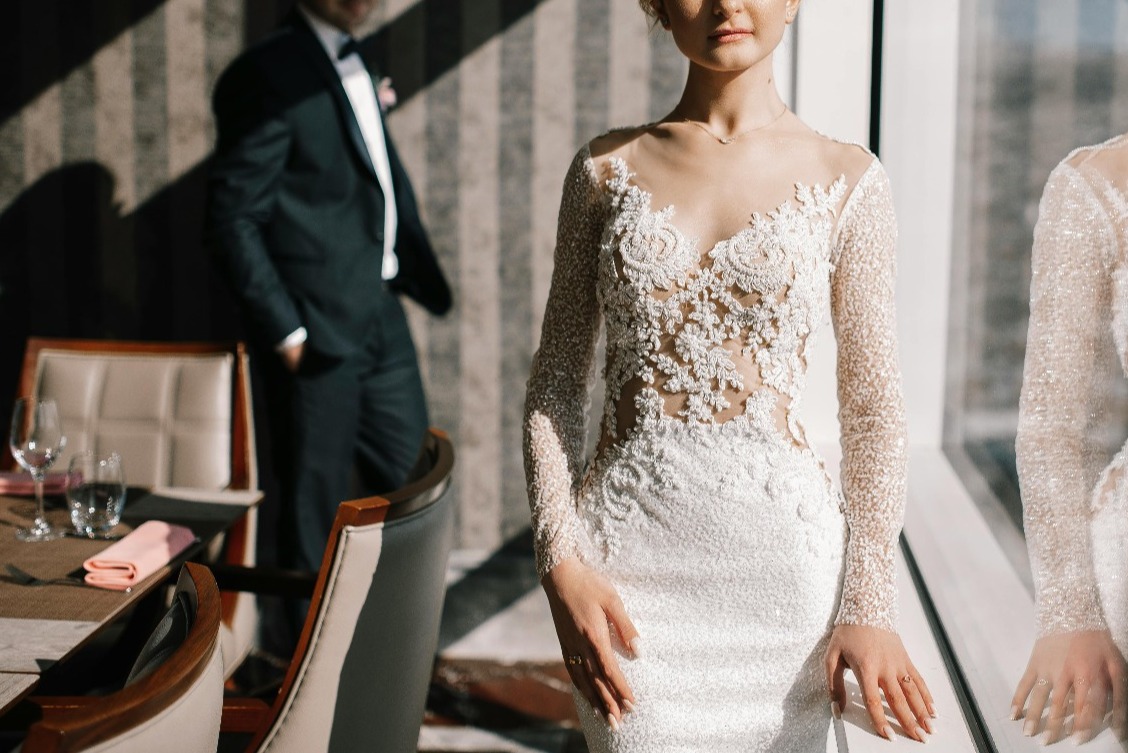The fabric that your wedding dress is made of is going to have a drastic impact on the overall design. You can have two dresses with identical silhouettes but, if they're made out of different fabrics, they'll have completely different aesthetics. Different materials sit differently, drape differently, and move differently, which effects how they look and how they feel - and that's without even getting into how the weight and breathability of different fabrics impacts how they feel when worn.
Read on for more information about which materials work best for which styles and seasons.
opaque
brocade
Brocade is a thick, luxurious fabric made from silk or synthetic fibres, and features raised patterns woven into the design, known as jacquard. The jacquard is a fantastic option for adding detail to a dress without using over the top embellishments. It's a relatively heavy, thick material, and its stiffness makes it a great choice for structured gowns, such as ballgowns, A-lines, or column dresses, especially those that are going to be worn in cold winter weather or at formal weddings.
charmeuse
Delicate and sensual, charmeuse is most commonly made of silk, but can be made out of synthetic materials, and has a glossy shine on the outside and a matte finish on the inside. It tends to fall in a soft drape that follows the curves of the body, making it perfect for dresses that are slim fitting but still loose, like sheath or slip dresses. Luxurious but lightweight, this slinky material is ideal for warmer weather, formal spring and summer weddings.
crepe
This textured, matte fabric is lightweight enough to fall in soft drapes, but is still structured and shapely. Traditionally made of silk, modern crepe fabric can be made out of a variety of materials, from cotton, to wool, to rayon - what distinguishes it is how the fibres are tightly twisted together to create its crimped texture. This has the added bonus of making it a wrinkle-resistant fabric, which might explain why its so popular for destination weddings where brides will be travelling with their dress. It's perfect for gowns that you want to flow, but not float, like softly structured A-line or fit and flare dresses, and is popular for formal, minimalist designs in every season.
damask
Damask is like a lighter version of brocade - it's a luxurious fabric made from silk or synthetic fibres, and features raised patterns woven into the design, known as jacquard. The jacquard is a fantastic option for adding detail to a dress without using over the top embellishments. The stiffness of damask makes it a great choice for structured gowns, such as ballgowns, A-lines, or column dresses, and its lighter weight make it a great choice for formal weddings at any time of year.
dotted swiss
The key feature of this fabric, also known as swiss knot, is the small dots that embellish it. The dots are evenly spaced across the entirety of the muslin fabric, which creates a fun pattern without being too busy. Popular in the 40s and 50s, it has quite a retro feel that makes it a common choice for tea length dresses, and just enough whimsy to also make it popular for full length, flowy dresses at casual garden weddings. It's lightweight and breathable, perfect for warm weather spring and summer weddings.
dupioni
Dupioni is a heavy, pure silk, distinguished by its slightly rough, coarse texture. Despite having more an organic feel to it, however, dupioni still has a beautiful silky sheen. Its thicker composure means it holds its shape well, making it a popular choice for formal gowns with both structure and drama, like voluminous ball gowns or structured column dresses. Due to being silk, however, it's still breathable, which makes it a great fabric option no matter what time of year your wedding is.
faille
This structured, matte material is finished with a ribbed effect that gives it a unique texture. It's traditionally made of woven silk, cotton or wool, but modern dresses can also be made of rayon. It holds its shape well, and is an incredibly popular material for gowns that you want to flow, but not float, like softly structured A-line or fit and flare dresses. Due to how lightweight it is, it's commonly used in minimalist designs across every season.
jersey
Soft and stretchy, jersey is a knit fabric that's comfortable, affordable and low-maintenance. It was originally made only out of wool, but modern versions can be made of wool, cotton or synthetic fibres. It's a wrinkle-resistant fabric, which makes it a popular for destination weddings where brides will be travelling with their dress. The stretch works well for relaxed fit and flare or sheath silhouettes, and it's also breathable, which makes a good option for casual weddings in warmer seasons, like spring and summer.
mikado
Mikado is a thick, structured silk with a glossy, shiny finish. It can be made from natural silk, or a blend of natural and synthetic fibres, and is a heavier blend than other silks. This density means that it stays relatively wrinkle free and crisp and, combined with its soft texture, makes it perfect for sculpting into sophisticated, structured gowns such as form-fitting mermaids or voluminous ballgowns. This luxurious material can be worn year round, but it's most popular for formal weddings in the colder autumn and winter months.
sheer
batiste
This is a transparent fabric that has an airy, soft appearance and is used as an overlay for bodices or skirts, or on its own for sheer sleeves. Made of plain weave, its lightweight nature makes it perfect for warmer weather weddings, but the material has enough structure to still feel sophisticated. It's most commonly seen on A-line dresses, but can be used on any silhouette. Due to usually being used an overlay, it can also be worn in any season and at any type of wedding.
chiffon
Lightweight and sheer, chiffon is commonly used as an overlay over heavier, opaque materials, or layered upon itself multiple times. It can be made of woven silk or polyester and rayon, but either way it's quite a delicate and fragile fabric that wrinkles and snags fairly easily. Its translucent nature and light, airy structure make it appear to float, almost weightless, which gives it a dreamy, ethereal aesthetic. It's typically seen on A-line and empire waist gowns, leaning in to those whimsical fairy vibes, and is perfect for warmer weather weddings in spring and summer. In terms of formality, it can be dressed up or down depending on the rest of the styling.
gazar
Gazar is a crisp, gauzy fabric that holds its shape well but still appears airy and light. Made out of wool or silk - with silk being the more common option when it comes to bridal wear - this sheer fabric has a smooth but stiff texture that allows it hold its shape well, but is prone to creasing. It's a great option for structured gowns with fuller skirts, like ballgowns or A-lines, and the fact that it's a lighter fabric makes it a popular choice for formal weddings at any time of year.
georgette
Lightweight and sheer, but slightly less translucent than chiffon, georgette is commonly used as an overlay over heavier, opaque materials, or layered upon itself multiple times. It's made from spun strands of silk or polyester, which give it a slightly crisp, crepe like texture. It's light, airy structure makes it appear to float as it swishes and moves with the wearer, which gives it a dreamy, ethereal aesthetic. It's typically seen on soft A-line and empire waist gowns, leaning in to those whimsical boho vibes, and is perfect for warmer weather weddings in spring and summer. In terms of formality, it can be dressed up or down depending on the rest of the styling.
lace
Lace is the quintessential bridal fabric. It's made from silk or cotton, and is available in a huge range of styles that can vary drastically in pattern, weight and texture, although they all have a sense of romance about them. The intricacy of lace patterns means that altering these dresses, whether it be taking them in or out, altering the bust line or hemming them, is going to be more time consuming and more expensive than other materials.
alençon
A corded weave that features bold, raised motifs outlined by a thicker cord, on a sheer or netted background, Alençon lace is one of the most popular ones found on bridal gowns of all styles. The intricate botanical designs paired with the unique, visible texture of the raised cords make this lace particularly eye catching. It can take the form of an overlay that covers the majority of a dress, or be used as an embellishment just on the bodice, sleeves and train.
chantilly
Chantilly lace is also incredibly popular for bridal wear - it's delicate and dainty, featuring an ornate pattern of highly detailed flowers made of thin, flat weave and outlined in fine thread, on a background of hexagonal netting. It often features a scalloped, fringed edge. It's soft, airy and romantic, and can be found as an overlay over the entire dress, or be used just for embellishing the bodice, sleeves and train.
eyelet
Instead of having a sheer or netted background, eyelet lace features a solid base fabric that is patterned with embroidered holes or cutouts. The patterns tend to be grouped into geometric shapes or floral arrangements, and are less dainty than those of traditional laces. This more modern vibe and its breathability make Eyelet lace a staple choice for boho dresses, where it's worn as an overlay or, sometimes, on its own. The flexibility of base fabric also makes this a popular choice for summer weddings.
guipure
Guipure is another type of lace that doesn't have a sheer or netted background - it actually has no background at all. Instead, it's made up of a dense, interwoven network of threads connected by bars or plaits in bold, unique patterns. This structure makes Guipure firmer, thicker and heavier than other laces, but the open spaces within the design ensure that it's still airy and breathable. The patterns are well defined and less ornate than other laces, usually consisting of 'simple' floral motifs or geometric shapes. This statement lace is used most commonly as an overlay for a whole dress.
venise
A highly textured lace, Venise is another style that doesn't utilise a sheer or netted background. Instead, the highly detailed and ornate floral and botanical designs are created with an open, intricate network of threads, using a combination of needlepoint and cordonnet techniques. This unique method creates highly dimensional motifs with raised outlines, and results in a lace that's heavy, highly textured and relatively durable. It's a popular embellishment on vintage-inspired gowns, particularly for weddings in colder weather.







